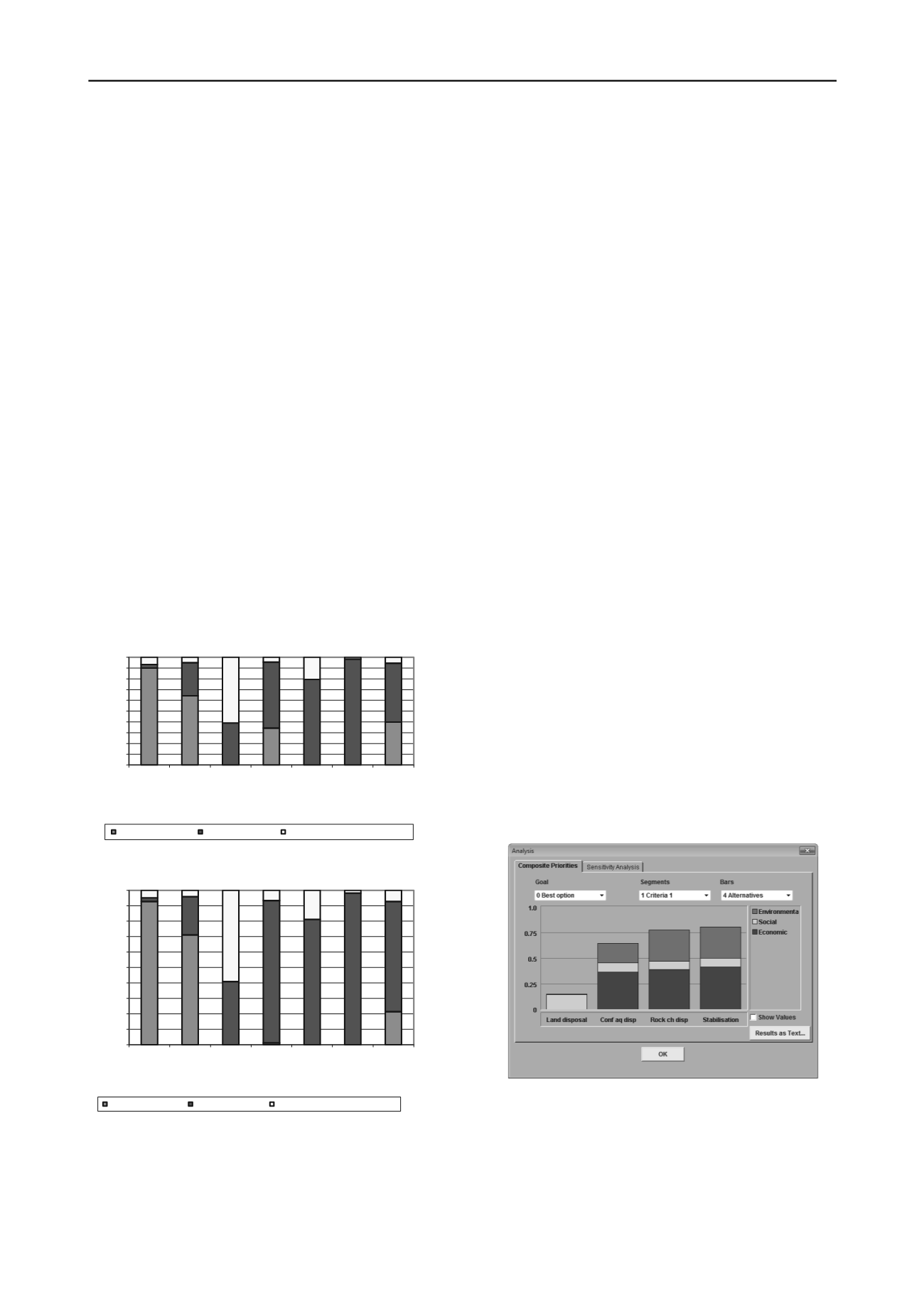
3217
Technical Committee 307 /
Comité technique 307
Proceedings of the 18
th
International Conference on Soil Mechanics and Geotechnical Engineering, Paris 2013
0%
10%
20%
30%
40%
50%
60%
70%
80%
90%
100%
S/S, Case 1 S/S and
landfill,
Case 1
Sea
disposal,
Case 1
METHA
sand/silt to
Road &
Landfill ,
Case 3
River
disposal,
Case 3
Sea
Disposal,
Case 3
Dewatering
& landfill ,
Case 3
Percentage of total climate impact
Production of material
Transport of material
Construction work and maintenance
The system boundaries were chosen with a comparative LCA
approach, i.e. identical activities in all scenarios were excluded,
aside from dredging activities. The system boundaries were
expanded and included also the beneficial utilization of the
sediment. Hence, the functional unit included the handling of
the sediment and also the production of the service that the
sediment would provide when utilized in quay, road, bricks etc.
Disposal scenarios also included the fulfillment of the service
but sediment material was substituted with the production and
use of conventional material.
LCA could provide the decision maker with a good view on
environmental impacts for either a certain activity or for a
comparison of different activities. The LCA could thus be used
in an early decision phase for comparing relative differences in
energy use and climate impact between different handling
options.
LCA could also be used for displaying the relation between
the energy use and climate impact from production of material,
transport of material and construction work and maintenance
respectively. This could be made with a stand-alone approach.
With the standalone LCA approach, it could be possible to
describe significant activities in each sediment management
alternative. Such approach demands a more extensive data
inventory but could provide information on which measures
should be taken in each management alternative to reduce the
energy use and climate impact. The stand-alone approach been
tested in a SMOCS case study and the result is presented in
Figure 4.
The data was collected from the cases of Oxelösund and
Hamburg and completed with data on previously excluded
activities such as dredging, transfers of dredged material.
Figure 4. Percentage of total energy use (top) and climate impact
(bottom) from the handling of sediments from in three categories of
activities. Case 1 is Port of Oxelösund, Sweden and Case 3 is Port of
Hamburg, Germany.
The overall conclusion from these LCA cases studies are that
the selection of handling alternative for sediment management
has major significance on the overall energy use and climate
impact. Furthermore, the energy use and climate impact from
transportation of materials and dredged material is often
significant in the context of sediment management
2.3
Multi Criteria Decision Analysis (MCDA)
Multi criteria decision analysis (MCDA) is a tool that can
integrate economic, environmental and social criteria and
identifying the most sustainable handling alternative in a
structured and rational way. Therefore, MCDA approach could
be used at the project level for establishing the overall favorable
handling alternative for management of contaminated sediments
from a sustainability perspective. However, in order to be able
to objectively score the performance of the different handling
alternatives used in the MCDA other assessment tools are
needed.
Within SMOCS MCDA case studies has been performed for
the Port of Gothenburg and the Port of Lübeck integrating
economic, social and environmental criteria for decision.
Fundamental steps in a MCDA are to (Belton and Stewart,
2001)
1. Identify possible handling options
2. Identify decision criteria and their indicators
3.
Weight decision criteria’s relative importance
4. Score the performance of the handling options in relation to
each decision criterion
5. Calculate results
Results from the case study in the Port of Gothenburg are
shown in Figure 5. A higher score should be interpreted as a
better overall result, meaning that Rock chamber disposal and
Solidification/stabilization are the most favorable options. A
handling alternative scoring best on all decision criteria would
result in the overall performance score 1.0. The bar colours
show the contributions of environmental, social and economic
criteria to the overall performance of each handling option. The
im
pact of the port’s weighting can be seen clearly: economic
and environmental criteria are given 2 and 1.5 times the weight
of social criteria, and hence these contribute more to the overall
performance.
Figure 5. The MCDA results for the Port of Gothenburg case study
showing the score of each handling option. A higher score means better
overall performance.
3 CONCLUSION
MCDA provides a structured way of thinking through the whole
range of decision criteria that should be taken into consideration
0%
10%
20%
30%
40%
50%
60%
70%
80%
90%
100%
S/S, Case 1 S/S and
landfill,
Case 1
Sea
disposal,
Case 1
METHA
sand/silt to
Road &
Landfill ,
Case 3
River
disposal,
Case 3
Sea
Disposal,
Case 3
Dewatering
& landfill ,
Case 3
Percentage of total energy use
Production of material
Transport of material
Construction work and maintenance


